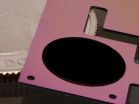(Press-News.org) The National Institute of Standards and Technology (NIST) has demonstrated a novel chip-scale instrument made of carbon nanotubes that may simplify absolute measurements of laser power, especially the light signals transmitted by optical fibers in telecommunications networks.
The prototype device, a miniature version of an instrument called a cryogenic radiometer, is a silicon chip topped with circular mats of carbon nanotubes standing on end.* The mini-radiometer builds on NIST's previous work using nanotubes, the world's darkest known substance, to make an ultraefficient, highly accurate optical power detector,** and advances NIST's ability to measure laser power delivered through fiber for calibration customers.***
"This is our play for leadership in laser power measurements," project leader John Lehman says. "This is arguably the coolest thing we've done with carbon nanotubes. They're not just black, but they also have the temperature properties needed to make components like electrical heaters truly multifunctional."
NIST and other national metrology institutes around the world measure laser power by tracing it to fundamental electrical units. Radiometers absorb energy from light and convert it to heat. Then the electrical power needed to cause the same temperature increase is measured. NIST researchers found that the mini-radiometer accurately measures both laser power (brought to it by an optical fiber) and the equivalent electrical power within the limitations of the imperfect experimental setup. The tests were performed at a temperature of 3.9 K, using light at the telecom wavelength of 1550 nanometers.
The tiny circular forests of tall, thin nanotubes called VANTAs ("vertically aligned nanotube arrays") have several desirable properties. Most importantly, they uniformly absorb light over a broad range of wavelengths and their electrical resistance depends on temperature. The versatile nanotubes perform three different functions in the radiometer. One VANTA mat serves as both a light absorber and an electrical heater, and a second VANTA mat serves as a thermistor (a component whose electrical resistance varies with temperature). The VANTA mats are grown on the micro-machined silicon chip, an instrument design that is easy to modify and duplicate. In this application, the individual nanotubes are about 10 nanometers in diameter and 150 micrometers long.
By contrast, ordinary cryogenic radiometers use more types of materials and are more difficult to make. They are typically hand assembled using a cavity painted with carbon as the light absorber, an electrical wire as the heater, and a semiconductor as the thermistor. Furthermore, these instruments need to be modeled and characterized extensively to adjust their sensitivity, whereas the equivalent capability in NIST's mini-radiometer is easily patterned in the silicon.
NIST plans to apply for a patent on the chip-scale radiometer. Simple changes such as improved temperature stability are expected to greatly improve device performance. Future research may also address extending the laser power range into the far infrared, and integration of the radiometer into a potential multipurpose "NIST on a chip" device.
INFORMATION:
* N.A. Tomlin, J.H. Lehman. Carbon nanotube electrical-substitution cryogenic radiometer: initial results. Optics Letters. Vol. 38, No. 2. Jan. 15, 2013.
** See 2010 NIST Tech Beat article, "Extreme Darkness: Carbon Nanotube Forest Covers NIST's Ultra-dark Detector," at www.nist.gov/pml/div686/dark_081710.cfm.
***See 2011 NIST Tech Beat article, "Prototype NIST Device Measures Absolute Optical Power in Fiber at Nanowatt Levels," at www.nist.gov/pml/div686/radiometer-122011.cfm.
NIST's 'nanotubes on a chip' may simplify optical power measurements
2013-01-25
ELSE PRESS RELEASES FROM THIS DATE:
Analysis of Greenland ice cores adds to historical record and provide glimpse into climate's future
2013-01-25
A new study that provides surprising details on changes in Earth's climate from more than 100,000 years ago indicates that the last interglacial--the period between "ice ages"--was warmer than previously thought and may be a good analog for future climate, as greenhouse gases increase in the atmosphere and global temperatures rise.
The research findings also indicate that melting of the massive West Antarctic ice sheet may have contributed more to sea-level rise at that time than melting of the Greenland ice sheet.
The new results from the North Greenland Eemian Ice ...
Emotional stress reduces effectiveness of prostate cancer therapies in animal model
2013-01-25
WINSTON-SALEM, N.C. – Jan. 25, 2013 – Not surprisingly, a cancer diagnosis creates stress. And patients with prostate cancer show higher levels of anxiety compared to other cancer patients.
A new study by researchers at Wake Forest Baptist Medical Center indicates that stress is not just an emotional side effect of the diagnosis; it also can reduce the effectiveness of prostate cancer drugs and accelerate the development of prostate cancer.
The findings are published in the February issue of the Journal of Clinical Investigation.
The Wake Forest Baptist team, headed ...
INRS develops a nanohybrid with remarkable properties using a new laser-plasma process
2013-01-25
Montreal, January 25, 2013 – By achieving the synthesis of a novel nanohybrid structure by means of the pulsed laser ablation (PLA) technique, Professor My Ali El Khakani and his team paved the way for a new generation of optoelectronic materials. The combination of carbon nanotubes and lead sulfide (PbS) nanoparticles was performed using an effective and relatively simple process that offers considerable latitude for creating other nanohybrids for a variety of applications. The INRS Énergie Matériaux Télécommunications Research Centre researcher's work, published in the ...
No more 'empty nest:' middle-aged adults face family pressure on both sides
2013-01-25
CORVALLIS, Ore. – The "empty nest" of past generations, in which the kids are grown up and middle-aged adults have more time to themselves, has been replaced in the United States by a nest that's full – kids who can't leave, can't find a job and aging parents who need more help than ever before.
According to a new study by researchers at Oregon State University, what was once a life stage of new freedoms, options and opportunities has largely disappeared.
An economic recession and tough job market has made it hard on young adults to start their careers and families. ...
New tool for mining bacterial genome for novel drugs
2013-01-25
Vanderbilt biochemists have discovered that the process bacteria undergo when they become drug resistant can act as a powerful tool for drug discovery.
Their findings – reported this week in the Online Early Edition of the Proceedings of the National Academy of Sciences – should give a major boost to natural products drug discovery – the process of finding new drugs from compounds isolated from living organisms – by substantially increasing the number of novel compounds that scientists can extract from individual microorganisms.
Bacteria have traditionally been the ...
New suite of chemicals seen causing disease generations later
2013-01-25
PULLMAN, Wash.—Washington State University researchers have lengthened their list of environmental toxicants that can negatively affect as many as three generations of an exposed animal's offspring.
Writing in the online journal PLOS ONE, scientists led by molecular biologist Michael Skinner document reproductive disease and obesity in the descendants of rats exposed to the plasticizer bisephenol-A, or BPA, as well DEHP and DBP, plastic compounds known as phthalates.
In a separate article in the journal Reproductive Toxicology, they report the first observation of cross-generation ...
Breast feeding okay for mothers taking immunosuppressant drug
2013-01-25
Highlights
The breast milk of mothers taking the immunosuppressant tacrolimus contains only very low levels of the drug.
Women taking tacrolimus who wish to breast-feed after appropriate counseling should not be discouraged from doing so.
Increasing numbers of pregnant women are taking tacrolimus after organ transplantation and for other conditions.
Washington, DC (January 24, 2013) — Women taking the immunosuppressant tacrolimus can rest assured that breast feeding will not elevate their babies' exposure to the drug, according to a study appearing in an upcoming ...
Kidney disease accounts for most of the increased risk of dying early among diabetics
2013-01-25
Highlights
Among people without diabetes or kidney disease, 10-year mortality was 7.7%.
Among individuals with diabetes but without kidney disease, mortality was 11.5%.
Among those with both diabetes and kidney disease, mortality was 31.1%.
26 million people in the US and 340 million people in the world have type 2 diabetes.
Washington, DC (January 24, 2013) — One in every 10 Americans has diabetes, and a third or more of those with the condition will develop kidney disease. It may be possible to live a long and healthy life with diabetes, but once kidney disease ...
Love triumphs over hate to make exotic new compound
2013-01-25
Northwestern University graduate student Jonathan Barnes had a hunch for creating an exotic new chemical compound, and his idea that the force of love is stronger than hate proved correct. He and his colleagues are the first to permanently interlock two identical tetracationic rings that normally are repelled by each other. Many experts had said it couldn't be done.
On the surface, the rings hate each other because each carries four positive charges (making them tetracationic). But Barnes discovered by introducing radicals (unpaired electrons) onto the scene, the researchers ...
Science needs a second opinion: Researchers find flaws in study of patients in 'vegetative state'
2013-01-25
NEW YORK (Jan. 24, 2013) -- A team of researchers led by Weill Cornell Medical College is calling into question the published statistics, methods and findings of a highly publicized research study that claimed bedside electroencephalography (EEG) identified evidence of awareness in three patients diagnosed to be in a vegetative state.
The new reanalysis study led by Weill Cornell neurologists Drs. Andrew Goldfine, Jonathan Victor, and Nicholas Schiff, published in the Jan. 26 issue of the journal Lancet, reports the statistical results and methodology used by a research ...

